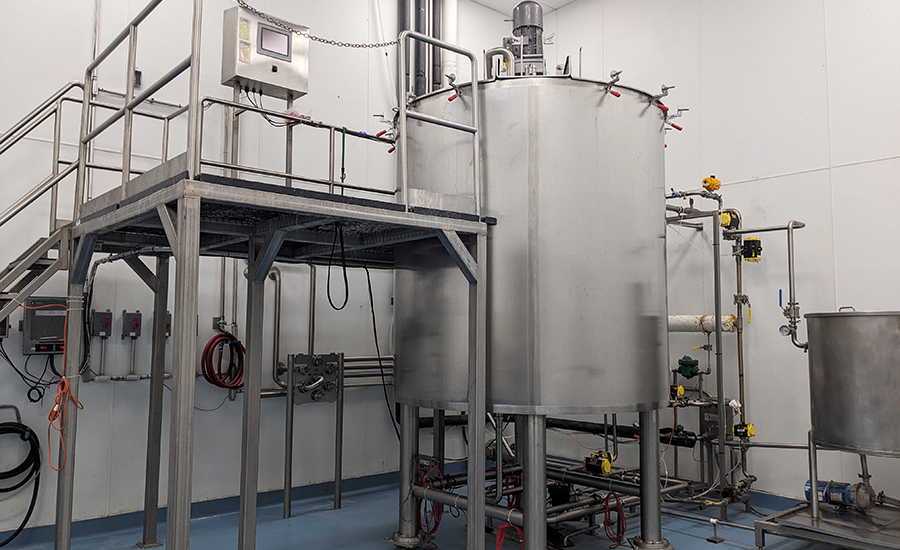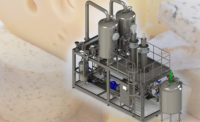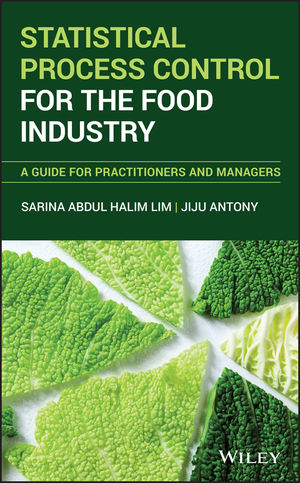Frozen Dessert Maker Maintains Authenticity with In-house Processing
Kaurina’s Kulfi could take shortcuts with its ‘Indian ice cream’ for more product and profit, but instead chooses a scaled up process first used in the family’s kitchen in order to stay true to the frozen treat’s heritage.

Image courtesy of Kaurina’s Kulfi
Nestled among various businesses in an industrial strip off of the Lyndon B. Johnson Freeway some 15 miles east of Dallas Fort Worth International Airport in Farmers Branch, Texas lies a sweet taste of India.
The facility is so nondescript that I drive past it a couple of times with neither the GPS on my phone or in my rental being any help as they keep losing a signal. I finally find it among the sea of connected beige bricks, glass entryways and roll-up doors by slowly driving through the long, narrow parking lot and looking around the smattering of small trees that dot the edges. I park the rental and walk inside.
Upon entering the unassuming lobby, I’m greeted by four people: Office Manager Tracy Huddleston, Production Manager Patrick Davis, CEO Aman Singh and President Hari Singh. Aside from a couple of other people I’ll meet later, the facility is empty. It’s a Friday and production isn’t happening, so the tour and manufacturing demonstration I’m about to see is all just for me. While such an honor would be great any time, it’s especially important this time because I have a lot of questions. The main one being: What is kulfi?
Aman Singh sort of shrugs and gives me a tolerant, well-rehearsed response honed by years of being asked that same question, “Indian ice cream.” But I learned it’s so much more than that.
I won’t get into the history of it all, that’s what the internet is for. But kulfi is essentially a traditional frozen Indian dessert that, yes, is essentially ice cream. It’s often made in household kitchens and sold on the streets in India, a country of roughly 1.4 billion people. So, it’s interesting that it isn’t more well known. This is made clear to me a week later while visiting friends whose parents were in from Toronto but are originally from India. I told them about my trip and got an incredulous, “You’ve never had kulfi before?” in response. It could just be my own ignorance since Kaurina’s Kulfi had been available in Costco for some time, but only in select regions and rotated in and out seasonally.

I mention all this because I’m pretty much blown away the first time I try it. It’s incredibly dense. So dense, that it’s a full 15 minutes after I take a 1.6-oz. Pistachio Almond mini pop out of its wrapper that a small drip finally makes its down the side and onto my hand. I normally don’t have the self control to wait that long before tasting a dessert that’s been put in front of me, but it was at Aman Singh’s insistence that I wait, not just to demonstrate the density but to enhance the flavor.
“The other ingredients that people put in ice cream, like gums and stabilizers, actually reduce the flavor,” says Singh. “Because of the film that it creates, it almost creates a barrier between what’s in the product and the stabilizer itself because it captures the water.
“They capture the water to reduce the size of the ice crystals, which gives you the creamy texture, because they [other ice cream makers] want you to have that creamy texture right from the get-go. Which is great, there’s nothing wrong with that,” he adds. “But with kulfi being true to form and trying to stay true to tradition, we don’t want any of those things. We want people to take a moment in life and enjoy it. So, the idea is you savor it slowly. You take your time, don't bite into it right away. If you take your time with it and eat it over 10, 15, 20 minutes, then you really, truly know what the enjoyment of a rich and creamy dessert is.”
The ingredients of the Pistachio Almond pop I try are half and half milk, cane sugar, roasted almonds, pistachios, fresh ground cardamom, natural green color (from plant extracts) and tapioca starch. That’s it. Caramelization of the half and half, the closest approximation in the U.S. to India’s buffalo milk, is the key to kulfi’s density and ability to have such rich flavors with so few ingredients.
Originally, this was done on a stovetop in the Singh’s kitchen with Jas Singh, the family matriarch, stirring the milk in a 2-gal. stockpot until it was just right—a process that took, and still takes, many hours. Flavoring was then added before the mix got poured into aluminum moulds that looked like giant thimbles and then placed in the freezer. The family would then spend the next day or so wrapping all of the frozen pops before taking them to be sold at stalls and local shops.
Amazingly, the process is almost exactly the same now in this 30,000-sq.-ft. facility as it was in the family kitchen. Perhaps the biggest difference, aside from the end-of-line packaging machinery, is the 1,000-gal. vat that replaced the 2-gal. stockpot.

“It’s the exact same thing, no shortcuts,” says Aman Singh. “We’ll fill this up with about 900 gal. of half and half, slow cook it and caramelize it for a whole day to get it to that right texture and consistency that you can only do through a slow cook because you have to slowly evaporate the milk to get it to that right caramelization point.”
He says that the company has tried all sorts of other ways to do it, but it never comes out right. They might be able to get the texture right but not the taste, and vice versa. It’s also why the operation has been kept totally in house instead of using a co-manufacturer. Singh says that the family did look into that, but the need to properly cook the milk was always a deal breaker because of the investment needed by the co-manufacturer for that first step. Doing the first step themselves and then providing the results to the co-manufacturer also proved to be too costly and too logistically challenging. Suggestions to use different ingredients that would speed up the process were turned down by the Singhs because it would compromise the quality.
“So, we realized we were going to have to do it ourselves,” Singh says. “We thought, ‘Okay, let’s build an ice cream plant. And here we are.”
The facility I was being shown wasn’t the one the company moved into straight out of the family kitchen. In between that and the current facility was a 5,000-sq.-ft. space used for almost 10 years until 2019. From that small facility, the company was able to supply five regions for Costco.
“We were just busting at the seams,” says Singh. “We were able to save enough money, get a small business loan and opened this facility in 2020.”
The facility currently houses the one 1,000-gal. vat, but there’s room for two. As mentioned earlier, about 900-gal. of half and half is poured into the vat and slow cooked for approximately a day to reach the proper look and consistency—a process that relies far more on human judgment than strict measurements.
“It's an artisan process. It's not simply about temperature and time. It's also about the visual,” says Singh. “And so it takes a trained eye after doing it many, many times to know when it's right. You can't just take a measurement or other metric to know that it's right.”
Once properly cooked, the milk is piped to a second room where the flavorings are added. Natural ingredients make up the flavor base, which is mixed with the milk in one of three tanks. Flavors that have chunks of ingredients, such as almonds in the Pistachio Almond, are added in the next step. This is to ensure that those bits stay suspended in the solution instead of accumulating at the bottom. Workers then scoop the chosen flavor out of a bucket after it’s been piped through, and then place it into the mould. As of right now, the company has five to six flavors in rotation.
Once the aluminum moulds are filled, 18 pops per form, they take a seven minute ride down a trough filled with brine chilled to -24° to freeze the kulfi. At the end of the trough, the moulds are removed, placed in a rack to drain excess brine before being briefly dipped in hot water to extract the pops for wrapping and packaging. Nearly the entire process is done manually, with only some automation occurring during the packaging steps.
Kaurina’s Kulfi sells kulfi in quarts in addition to boxes of pops. While the news has since made the rounds before this article being published, the company is trying something new with its packaging. (I was sworn to secrecy until the news was announced, and I even shut my recorder off—so I don’t have any quotes.) Kaurina’s Kulfi is literally turning the traditional quart on its head with the smaller end serving as the top and the larger end with the lid serving as the bottom.
The aim is to capitalize on the idea that eating kulfi is an experience. Opening the lid allows consumers to slide the entire contents of the quart onto a plate, in a bowl or onto whatever they choose to use for service. The unique makeup of the kulfi allows it all to come out as a single, formed piece. Consumers can then slice it and serve it like a cake.
The idea wouldn’t be possible if the company used shortcuts to making its kulfi, Singh says. And that commitment to producing kulfi with the family’s recipe—and not modifying it to speed production and profit—is why consumers who know kulfi are fans.
“What has motivated us is the support from the community, the support from our family and friends to keep pushing,” says Singh. “It's to share our culture, to share our heritage with the larger American community that we have adopted has become our home.
“But the fun part about kulfi is there's still a lot of people that haven’t tried it,” he adds, saying that trying new foods is a rarity because of the availability of foods from different, diverse cultures now. “So it's such a pleasure to see someone try a flavor or a texture for the very first time and see the reaction, because you don't get that that often.”
Looking for a reprint of this article?
From high-res PDFs to custom plaques, order your copy today!












